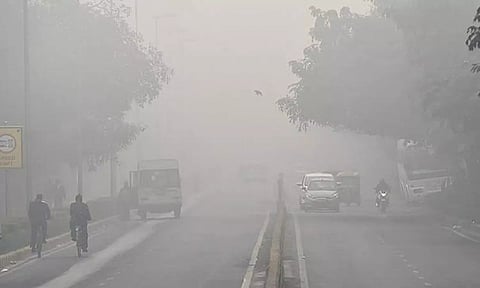

NEW DELHI: Delhi’s pollution level – PM2.5 concentration – saw its first huge spike of this winter season on November 2 with a sudden and staggering 68 per cent jump within 24 hours, crossing 313 microgramme per metre cubed which was equivalent to "severe plus" category as per the Air Quality Index (AQI) concentration range, the Centre for Science and Environment (CSE) said in its latest study.
It also said that stubble burning alone could not have led to this alarming spike in Delhi's air pollution levels if local factors, including vehicle emissions, had not already poisoned the national capital's air.
Releasing the new analysis by CSE of the deadly winter pollution that has gripped Delhi-NCR these days, CSE Executive Director, Research and Advocacy, Anumita Roychowdhury said: "This winter season has started with a much higher pollution level compared to November last year. The combination of adverse meteorological conditions, onset of crop residue burning, and high local pollution has tilted the scale dangerously, increasing public health risk.
"Even though the overall long-term pollution curve is stable and downward, it is still significantly above the national ambient air quality standards. This demands most stringent and sustained action on vehicles, industry, energy systems and waste management across the region."
The analysis has been done by CSE’s Urban Lab, whose head Avikal Somvanshi said: "This kind of rapid build-up is not uncommon during this part of the season and is generally associated with smoke-fall from farm stubble fire and meteorological factors assisting transportation of the smoke to Delhi-NCR and topping the high local pollution.
"But it must be kept in consideration that this rapid build-up in a short time span is able to tip air quality into severe category because baseline pollution from local sources is already very high."
The report pointed out that the most notable trend this year is the "sudden and rapid build-up of smog" episode in this early phase of winter. "On November 2, PM2.5 levels in Delhi crossed 300 microgrammes/cubic metre or 'severe plus' level for the first time this season. It was a very sudden escalation as the level rose a staggering 68 per cent within 24 hours," it said.
The analysis pointed out that during the previous five years, overall trends show that PM2.5 levels start to rise steadily from the beginning of October.
"This year, the levels started to rise from the middle of September. Illustratively, this increase was at a slower rate and by the end of October, the levels were 20-30 per cent lower than the average levels for the corresponding Octobers of the previous five winters – since 2018-19," it said.
It further pointed out that early beginning of bad air quality days this year due to lower rainfall during September and October.
"In contrast to the previous winter of 2022-23, the smog episode has started earlier this year. The last day with 'good' PM2.5 AQI before the onset of winter was observed on September 9, 2023," it said.
It remains to be seen how many more smog episodes with varying durations may occur this winter. As is the global practice, at least three continuous days of severe AQI is considered as one smog episode.
In previous winters, such episodes have been recorded lasting six-10 days the winters between 2018 and 2021 had, on an average, experienced three smog episodes each.
During the winter of 2022-23, only one smog episode was recorded from January 6-9. Also, Diwali and late December of 2022-23 did not witness a smog episode (like in the earlier winters).
The analysis by CSE's Urban Lab listed the key factors behind Delhi's toxic air. The report noted that this spike in pollution levels is not uncommon during this time of the year and is generally associated with stubble burning in north Indian states before farmers start work on the winter crop.
Meterological factors helping the movement of smoke to Delhi-NCR is also behind the jump in Delhi's Air Qualty Index, it said.
The report also stated that share of PM2.5 in PM10 is an important indicator of the impact of combustion sources.
"While coarser PM10 comes largely from dust sources, the tinier PM2.5 come more from vehicles, industry and open burning. This year the percentage share of PM2.5 in PM10 has crossed 50 per cent, which indicates higher impact of combustion sources. On November 2, the ratio for PM2.5 stood at 60 per cent -- highest this season indicating the higher influence of combustion sources," the report stated.
It further said that SAFAR's estimate has shown that the percentage contribution of farm stubble fire to Delhi’s PM2.5 concentration had crossed 25 per cent on November 2. "It was in the 10-20 per cent range in the week leading to November 2. This is expected to rise in the coming days. The fire instances in Punjab and Haryana are yet to peak. In previous years, on the worst days, its contribution had topped 40 per cent, as generally noted during the middle of November," it noted.
The report also stated that the levels of NO2 – which comes largely from vehicles -- are also rising in the region. "This indicates high impact of vehicular pollution. City-wide average NO2 is up by 60 per cent compared to the first week of October last year. Certain high traffic locations have been reporting levels as high as three-four times the 24-hour standard," it said.
ITO is most polluted NO2 location in Delhi, with an average of 219 microgrammes/cubic metre. Nehru Nagar and Siri Fort are the next most polluted NO2 locations in Delhi, the report said.